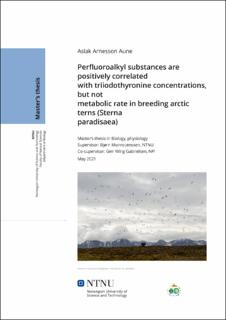| dc.contributor.advisor | Jenssen, Bjørn Munro | |
| dc.contributor.advisor | Gabrielsen, Geir Wing | |
| dc.contributor.author | Aune, Aslak Arnesson | |
| dc.date.accessioned | 2021-09-25T16:02:19Z | |
| dc.date.available | 2021-09-25T16:02:19Z | |
| dc.date.issued | 2021 | |
| dc.identifier | no.ntnu:inspera:79416900:15640960 | |
| dc.identifier.uri | https://hdl.handle.net/11250/2782473 | |
| dc.description.abstract | Perfluorerte alkylstoffer (PFAS) er allestedsnærværende miljøgifter, hvorav mange er svært
persistente. Forskning tyder på at denne kjemikaliegruppen har tyroidhormonforstyrrende
egenskaper og mulige effekter på metabolismen i eksponerte dyr, selv om sistnevnte er dårlig
dokumentert. Formålet med dette studiet var å undersøke konsentrasjoner og sammensetning
av sirkulerende PFASer i rugende rødnebbterner (Sterna paradisaea), og hvordan PFASene
korrelerte med totalt nivå av tyroksin (TT4) og trijodtyronin (TT3) og hvilemetabolisme
(RMR). Rødnebbterner (n=20) ble fanget og målt i Kongsfjorden, Svalbard, i perioden
juni/juli 2019. RMR ble målt i et åpent respirometer og PFASer ble kvantifisert i helblod med
væskekromatografi-massespektrometri (LC-MS), mens TT4 og TT3 ble kvantifisert i
blodplasma med radioimmunoassay (RIA). De topp tre dominerende PFASene i
rødnebbternene var, i synkende rekkefølge, linear perfluoroktan sulfonat (linPFOS),
perfluorundekanoat (PFUnDA) og perfluortridekanoat (PFTrDA), hvilket er konsekvent med
PFAS komposisjonen i andre arktiske sjøfugler i Kongsfjorden. Dette mønsteret indikerer at
det kan være lokale kilder i Kongsfjorden, selv om langtransporterte (LRT) PFASer
sannsynligvis er den største eksponeringskilden. Hanner hadde signifikante høyere
konsentrasjoner av den fleste PFASer sammenlignet med hunner. ∑PFAS, ∑perfluorerte
karboksylsyrer (PFCA), ∑perfluorerte sulfonsyrer (PFSA), ∑PFOS og sju spesifikke PFASer
(forgreinet PFOS, linPFOS og fem PFCAer) var signifikant positivt korrelert med TT3 i
begge kjønn kombinert, mens perfluordodekanoat (PFDoDA) og PFTrDA var signifikant
negativt korrelert med ratioen av TT4/TT3. I hunner var ∑PFAS, ∑PFSA, ∑PFOS og fire
spesifikke PFASer (linPFOS og tre PFCAer) signifikant positivt korrelert med TT3. Ingen
PFASer var korrelert med TT3 i hanner, og hverken TT4 eller RMR korrelerte med noen
PFASer i noen kjønn. Videre forskning er anbefalt for å kartlegge mekanismene bak den
positive korrelasjonen mellom spesifikke PFASer og tyroidhormoner, og derfor mulige
tyroidhormonforstyrrende effekter av PFASer og de mulige økologiske konsekvensene av
dette. | |
| dc.description.abstract | Perfluoroalkyl substances (PFAS) are ubiquitous environmental pollutants, many of which are
highly persistent, and mounting evidence suggests this group of chemicals has thyroid
hormone (TH) disruptive properties and possible effects on the metabolic rate of exposed
animals, though the latter is poorly documented. This study aimed to investigate the
concentrations and patterns of circulating PFASs in incubating arctic terns (Sterna
paradisaea), and how the PFASs correlated with total thyroxine (TT4) and triiodothyronine
(TT3) concentrations and resting metabolic rate (RMR). Arctic terns (n=20) were trapped and
sampled in Kongsfjorden, Svalbard, during June/July 2019. RMR was measured in an open
circuit respirometry chamber and PFASs were quantified in whole blood by liquid
chromatography–mass spectrometry (LC-MS), whereas TT4 and TT3 were quantified in
plasma by radioimmunoassay (RIA). The top three dominating PFASs in the arctic terns
were, in decreasing order, linear perfluorooctane sulfonate (linPFOS), perfluoroundecanoate
(PFUnDA), and perfluorotridecanoate (PFTrDA) which is consistent with PFAS compositions
reported in other arctic seabird species in Kongsfjorden. This pattern indicates there could be
some local sources in Kongsfjorden, although long-range transported (LRT) PFAS is likely
the main exposure source. Males had significantly higher concentrations of most PFASs,
compared to females. ∑PFAS, ∑perfluoroalkyl carboxylic acids (PFCA), ∑perfluoroalkyl
sulfonic acids (PFSA), ∑PFOS, and seven specific PFASs (branched PFOS, linPFOS, and
five PFCAs) were significantly positively correlated with TT3 in both sexes combined,
whereas perfluorododecanoate (PFDoDA) and PFTrDA were significantly negatively
correlated with the TT4/TT3 ratio. In females, ∑PFAS, ∑PFSA, ∑PFOS, and four specific
PFASs (linPFOS and three PFCAs) were significantly positively correlated with TT3. No
PFASs were correlated with TT3 in males and neither TT4 nor RMR was significantly
correlated with any PFASs in neither sex. Further research is recommended to unravel the
driving mechanisms behind the positive correlations between specific PFASs and THs, and
thus the possible TH disruptive effects of PFAS and their potential ecological consequences. | |
| dc.language | eng | |
| dc.publisher | NTNU | |
| dc.title | Perfluoroalkyl substances are positively correlated
with triiodothyronine concentrations, but not
metabolic rate in breeding arctic terns (Sterna
paradisaea) | |
| dc.type | Master thesis | |
